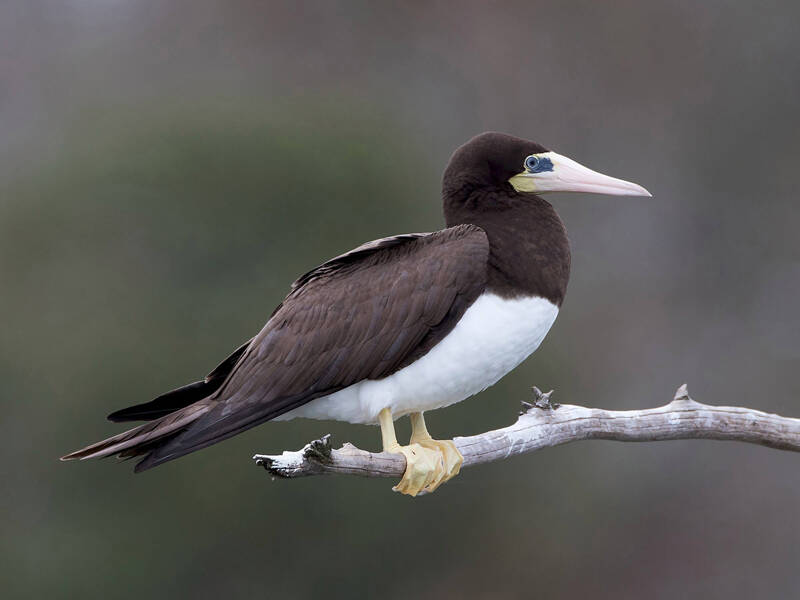Brown Booby
IUCN
LCBasic Information
Scientific classification
- name:Brown Booby
- Scientific Name:Sula leucogaster
- Outline:Waterfowl
- Family:Suliformes Sulidae Sula
Vital signs
- length:64-74cm
- Weight:1kg
- lifetime:10-20year
Feature
Good at flying and swimming, bold in temperament, with loud and rough calls
Distribution and Habitat
Distributed in American Samoa, Anguilla, Antigua and Barbuda, Argentina, Aruba, Australia, Bahamas, Barbados, Belize, Bonaire, St. Eustatius and Saba, Brazil, British Indian Ocean Territory, Brunei, Canada, Cape Verde, Cayman Islands, China, Christmas Island, Cocos Islands, Colombia, Comoros, Cook Islands, Costa Rica, Cuba, Curacao, Djibouti, Dominica, Dominican Republic, Ecuador, Egypt, El Salvador, Equatorial Guinea, Eritrea, Fiji, French Guiana, French Polynesia, Gabon, Grenada, Guadeloupe, Guam, Guatemala, Guinea, Guinea-Bissau, Guyana, Haiti, Honduras, India, Indonesia, Israel, Jamaica, Japan, Jordan, Kenya, Kiribati, Liberia, Madagascar, Malaysia, Maldives, Marshall Islands, Martinique, Mauritania, Mayotte, Mexico, Federated States of Micronesia, Montserrat, Myanmar, Nauru, Netherlands Antilles (Bonaire), New Caledonia, Nicaragua, Nigeria, Northern Mariana Islands, Oman, Palau, Panama, Philippines, Puerto Rico, Saint Helena, Ascension Island and Tristan - Cunha, St. Kitts and Nev
Appearance
The brown booby is large, slender and streamlined. The bill is thick, long, straight and pointed, almost conical, and yellow. The inside of the base of the female's bill and the exposed skin around the eyes are the same yellow as the bill, while the male is light blue. The head, neck and chest are dark brown, and the lower part of the chest is white. The wings are narrow, long and pointed, and the upper part is dark brown. The underwing coverts and axillary feathers are white, long and pointed, and black. The feet are short and thick, and light yellow.
The head, neck and entire upper body of the young bird are lighter brown, and the white part of the lower body has brown spots. The white part of the wings also has brown spots. The rest is similar to the adult bird.
Size measurement: body length 640-740 mm; bill peak 93-108 mm; wings 386-414 mm; tail 188-192 mm; tarsus 45-53 mm. (Note: ♂ male; ♀ female)
Details
Brown Booby, also known as Brown Booby, is a waterfowl and large seabird with 5 subspecies.

Brown Booby often lives in groups and has strong flying ability. They often continue to glide after flapping their wings for a distance, alternating between the two methods. They are also good at swimming and diving. When they rest, they either float on the water and drift with the current, or stand on the rocks on the shore. They are bold in temperament, with loud and rough calls. They mainly feed on various fish. They also eat squid and crustaceans. They mainly forage by diving. They often swim and dive into the water from time to time to chase fish schools. Sometimes they fly over the sea, retract their wings and suddenly dive into the water after finding prey, and then dive to chase prey. Sometimes they track prey hundreds of kilometers away at sea.
Brown boobies are mainly resident birds. They nest on islands in tropical and subtropical oceans and on rocks on the coast. Most of the nests are built on the ground on the edge of cliffs, and sometimes they also nest in small bushes or coral islands. They often form loose nests in groups, usually 2-3 nests together, very close to each other. The nest is made of branches and hay. When courting, the male and female birds each hold a branch on their feet, stand facing each other, and then wrap their necks around each other. Each nest lays 2 eggs, occasionally 3. The color is light green or light blue. The size of the egg is 61×40 mm.
Hunted as food: Local people capture adult birds and steal bird eggs, which are endangered factors for brown boobies. Brown boobies used to be more easily seen in the southeastern coast of China, the Xisha Islands, Hainan Island and other places, but due to human hunting and egg picking, the number has decreased and it is difficult to see.
Listed in the "Red List of Endangered Species of the World Conservation Union" (IUCN) 2018 ver 3.1-Least Concern (LC).
Listed in China's "National Key Protected Wildlife List" (February 5, 2021) Level 2.
Protect wildlife and eliminate game.
Maintaining ecological balance is everyone's responsibility!








